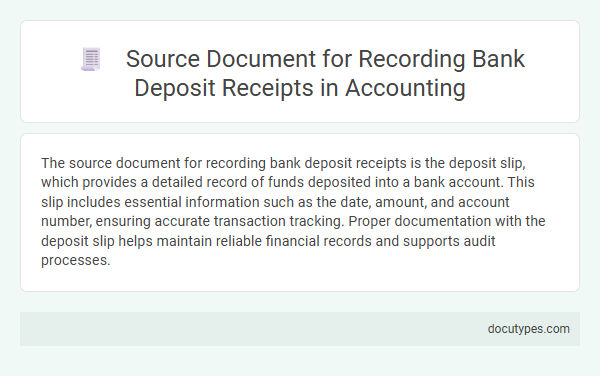The source document for recording bank deposit receipts is the deposit slip, which provides a detailed record of funds deposited into a bank account. This slip includes essential information such as the date, amount, and account number, ensuring accurate transaction tracking. Proper documentation with the deposit slip helps maintain reliable financial records and supports audit processes.
Introduction to Source Documents in Accounting
Source documents are the original records that provide evidence for accounting transactions. The source document for recording bank deposit receipts plays a crucial role in verifying financial entries.
- Definition of Source Documents - Source documents serve as the initial proof of a financial transaction occurring.
- Identification of Bank Deposit Receipts - Bank deposit slips or deposit confirmation statements act as source documents for deposits.
- Importance for Your Accounting Records - Using accurate source documents ensures your financial records remain reliable and auditable.
Importance of Bank Deposit Receipts
What is the source document for recording bank deposit receipts? The source document for recording bank deposit receipts is the bank deposit slip. This document serves as proof of the transaction and details the amount deposited, ensuring accurate financial records.
Why is the bank deposit receipt important for your records? Bank deposit receipts provide verification of funds deposited, which is essential for tracking cash flow and reconciling bank statements. Maintaining these receipts helps prevent errors and supports transparent financial reporting.
Definition of Bank Deposit Receipts
Bank deposit receipts serve as official source documents verifying the amount of money deposited into a bank account. These receipts include essential details such as the depositor's name, date of transaction, and the deposited amount. You rely on these documents to accurately record and track your bank deposit transactions in financial records.
Role of Source Documents in Bank Transactions
The source document for recording bank deposit receipts is the deposit slip or deposit confirmation issued by the bank. This document serves as tangible proof of the amount deposited into the account.
Source documents play a crucial role in bank transactions by providing accurate and verifiable evidence of financial activities. They ensure accountability and transparency in the recording process, helping to prevent errors or fraud. When you deposit money, the deposit slip acts as the official record to verify the transaction for both the bank and your personal records.
Components of a Bank Deposit Receipt
A bank deposit receipt serves as the primary source document for recording bank deposit transactions. It provides a formal acknowledgment from the bank confirming the details of the deposit made by an individual or business.
- Date of Deposit - Indicates the exact date when the funds were deposited into the bank.
- Deposit Amount - Specifies the total sum of money deposited, including cash and checks.
- Account Number - Identifies the bank account where the deposit was credited.
The bank deposit receipt ensures accurate financial record-keeping by verifying the authenticity and specifics of the deposit transaction.
Recording Bank Deposits in Accounting Books
The source document for recording bank deposit receipts is the bank deposit slip. This slip serves as official evidence of the transaction and provides essential details like the date, amount, and account number.
Recording bank deposits in accounting books begins with this deposit slip to ensure accuracy. You must enter the details into the cash or bank ledger to reflect the actual deposit and maintain financial records accurately.
Verification and Audit Trail Using Deposit Receipts
The source document for recording bank deposit receipts is the deposit slip provided by the bank at the time of the transaction. This document plays a crucial role in verifying the accuracy of deposits and maintaining a clear audit trail for financial records.
- Verification of Transactions - Deposit slips confirm the amount of money deposited, matching the recorded entries in accounting systems.
- Audit Trail Documentation - These receipts serve as physical evidence for auditors to trace cash flows and validate deposit entries.
- Dispute Resolution - In case of discrepancies, deposit receipts provide proof to resolve conflicts between the bank and the depositor.
Common Errors in Handling Deposit Receipts
The source document for recording bank deposit receipts is typically the deposit slip, which serves as proof of funds deposited into the bank account. This document details the date, amount, and account information essential for accurate financial records.
Common errors in handling deposit receipts include misrecording the deposit amount and failing to match the receipt with bank statements. You must verify all details on the slip to prevent discrepancies and ensure accurate bookkeeping.
Retention and Storage of Deposit Receipts
| Source Document for Recording Bank Deposit Receipts | Bank deposit slips or deposit confirmations issued by the bank serve as the primary source documents for recording bank deposit receipts. These documents verify the amount deposited and provide essential transaction details. |
|---|---|
| Retention Period for Deposit Receipts | Financial regulations typically require retaining deposit receipts for a minimum of 5 to 7 years. This retention period ensures compliance with auditing standards, tax laws, and internal financial controls. |
| Storage Methods for Deposit Receipts | Deposit receipts should be stored securely in physical or digital formats. Physical documents require organized filing systems in locked cabinets. Digital copies must be stored using encrypted backups, cloud storage solutions, or secure servers to prevent data loss and unauthorized access. |
| Importance of Retention and Storage | Proper retention and storage of bank deposit receipts facilitate accurate financial reporting, support audit trails, and protect against discrepancies. Maintaining organized records aids in dispute resolution and complies with legal and regulatory requirements. |
What Is the Source Document for Recording Bank Deposit Receipts? Infographic

